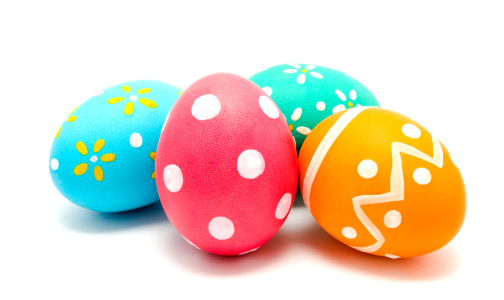Tipsheets are an eggcellent idea, demonstrates this Silver Anvil winner
When Americans bought more plastic and candy eggs and fewer real eggs for Easter 2012, the American Egg Board turned to Edelman to take back Easter.

But Edelman and the Egg Board didn’t send out releases and tweets saying, “Eggs are great.” Instead, they created tip sheets on how to hard-boil, dye, decorate eggs and create dishes for Easter.
The result of this and other campaign tactics: Americans bought more than $40 million extra eggs for Easter 2013. And Edelman and the Egg Board earned a PRSA Silver Anvil award for their campaign.
They’re incredible! They’re not edible! They’re tip sheets!
And that, my friends, is the power of tip sheets.
Tipsheets are more likely to get read, shared, used and acted upon, according to research. They’re also, obviously, more likely to sell eggs — not to mention other products, services, programs and ideas.
Here’s a look at one of Edelman and the Egg Board’s tip sheets. How can you model this master to create powerful tip sheets for your own campaigns?
Nothing Hard About It: Hard-Boiling Made Easy
Make Perfect Hard-Boiled Eggs for Decorating
It’s no “yolk” when egg whites turn rubbery and the yolks are green! If this happens to you, you’re not alone — most Americans still struggle with how to hard-boil eggs. In fact, in 2012 there were more than four million online searches for hard-boiled egg-related terms, and a recent American Egg Board survey found that less than one-quarter (23%) of respondents know the correct way to hard-boil eggs. Luckily, all it takes is a little know-how to get hard-boiled eggs done to perfection, every time!
THREE simple steps to properly hard-boil eggs:
- Place eggs in saucepan large enough to hold them in a single layer. Add cold water to cover eggs by one inch. Heat over high heat just to boiling.
- Remove from burner. Cover pan. Let eggs stand in hot water about 12 minutes for Large eggs (9 minutes for Medium eggs; 15 for Extra Large).
- Cool completely under cold running water or in a bowl of ice water. Peel and eat eggs or refrigerate them in their shells to enjoy up to a week later.
The HARD facts:
- Boiled, but just barely. While the cooking water must come to a full boil, the pan is immediately removed from the heat so that the eggs cook gently in the hot water to produce tender eggs and minimize cracking.
- Very fresh eggs can be difficult to peel. Buy and refrigerate your eggs a week to 10 days in advance of cooking them to make peeling easier. This brief “breather” allows the eggs time to take in air, which helps separate the membranes from the shell.
- Hard-boiled eggs are easiest to peel after cooling. Cooling causes the egg to contract slightly in the shell.
- Peel a hard-boiled egg. Gently tap egg on your countertop until the shell is finely cracked all over, then roll it between your hands to loosen the shell. Peel starting at the large end and hold the egg under cold running water to help ease the shell off.
- Banish the greenish ring. This harmless but unsightly discoloration that sometimes forms around hard-boiled yolks results from a reaction between sulfur in the egg white and iron in the yolk. It occurs when eggs have been cooked for too long or at too high a temperature.
- Hard-boiled eggs in the shell can be refrigerated safely for up to one week. Peeled hard- boiled eggs should be eaten that day. Uncooked, eggs can stay fresh in a refrigerator for up to a month or more.
- Prepare a dozen hard-boiled eggs on Sunday for an all-natural, high-quality protein option and vitamin D boost on hand for your family’s big days, either for an on-the-go breakfast or after-school snack.
To Dye-For: Tips and Tricks to Dress Your Eggs for Easter
In 2012, there were more than three million online searches for egg decorating, one of America’s favorite Easter traditions! And a recent American Egg Board survey reveals nearly two-thirds (61%) of respondents say their families decorate one to two dozen eggs each year. Whether using an egg coloring kit or dyeing eggs naturally, get creative this Easter season with these quick and easy decorating tips from HGTV interior designer, Sabrina Soto.
Ready, Set, Dye. Start with clean, cool, hard-boiled eggs. Make sure everyone washes their hands in hot, soapy water before and after handling eggs. This protects the eggshell from any oils on hands that may prevent dye from adhering.
Get a Grip. Enlist the help of accessories like an egg dipper, which can be found in egg coloring kits, to hold on to those eggs while coloring them. This “egg-cential” accessory helps little hands dip it into the dye securely.
Color Me Happy. More than two-thirds of egg decorators buy kits each year to help dye eggs, and anticipate coral will be the hot color of the Easter season. When using a coloring kit, vary the color of egg dye by adding different ingredients to the color tablet. For ultra-vibrant colored eggs, add vinegar. Looking for more traditional colored eggs? Use lemon juice. To embrace the pastel colors of spring, just use water.
Ombre. Purchase basic spray paint from your local craft store. Begin by spray painting one end of the egg with a heavy coat and lightening the coats as you work your way up to the opposite end of the egg. You’ll achieve a beautiful ombre effect. Introduce a new color by spray painting the other end and blending the colors in the middle.
Doodle Design. Eggs don’t have to be dyed to look special! Get a thin sharpie marker and doodle away. Create beautiful designs and patterns around the egg. Paisley and flowers are simple to make. Start with a leaf or a daisy shape and keep building off that design until the egg is fully decorated!
Re-Pin It to Win It. Visit the Incredible Egg on Pinterest for more inspiring ideas and showcase your unique egg design when the “Easter Eggs-travaganza Sweepstakes” kicks off on March 18. The grand prize winner will receive a gift card valued at $1,000 to put toward a room makeover and four runners-up will receive a gift card valued at $200.
Color Your Easter with Eggs
HGTV Interior Designer Sabrina Soto
Offers Easter Decorating Tips to “Dye” for
Nearly 200 million eggs are purchased for Easter celebrations in the U.S. every year. Whether young or young at heart, hard-boiling eggs and then decorating them is a favorite family pastime that brings out the creative side in everyone. According to a recent American Egg Board survey, nearly two-thirds (61%) of respondents say their families decorate one to two dozen eggs each year.
“Eggs are like a blank canvas — the decorating possibilities are endless, and you don’t have to stick to a standard store-bought kit,” says Sabrina Soto, HGTV interior designer. “In addition to dyeing eggs in beautiful colors, dress them up with items already sitting in your kitchen or closet like scraps of ribbon, buttons, glitter or even confetti.”
Here are a few more tips from Soto to get the egg decorating creativity hopping:
- Perfect Polka: Use the eraser end of a pencil to paint perfect polka dots on the egg. Just dip the eraser into acrylic craft paint and dab onto the egg. Make different patterns and use different colors to create perfect designs.
- Tattoo Decor: Kids always have those temporary tattoos lying around their rooms! Why not make egg decorating simple? Apply those same tattoos to eggs for a professional and easy look that kids will love.
- Ribbon Wrap: Tie a beautiful ribbon around a dyed egg. Mix colors and patterns for fun visual interest. Adorn with craft or fabric flowers, even buttons. For a more rustic look, use natural fibers such as hemp or twine with dried flowers in place of the ribbons.
Before Decorating, You Have to Hard-Boil
“After interior design, cooking is my second passion,” says Soto. “It always surprises me that while many people love to decorate eggs, they don’t know how to hard-boil eggs properly.”
In fact, less than one-quarter (23%) of survey respondents know the correct way to hard-boil eggs. What many don’t know is the key to hard-boiling eggs is not to boil them. Eggs that are cooked too long or at too high of a temperature become tough and rubbery, causing them to have unattractive green rings around the yolks. Follow these steps for bright yellow yolks and tender whites every time:
- Step 1: Put eggs in pan, add water, cover, bring to boil
- Step 2: Turn off heat, let stand for 12 minutes
- Step 3: Run cold water over eggs to cool and get ready to decorate
Soto recommends buying eggs a week to 10 days before decorating so they will be easier to peel.
Visit the Incredible Egg on Pinterest for more inspiring ideas and showcase your unique egg design when the “Easter Eggs-stravaganza Sweepstakes” kicks off on March 18. The grand prize winner will receive a gift card valued at $1,000 to put toward a room makeover and four runners-up will receive a gift card valued at $200.
Incredible Easy Egg Recipes
In addition to being great for festivities, eggs are affordable, contain high-quality protein and are a naturally good source of vitamin D, making them an ideal dish to serve a group at Easter brunch. Try these delicious and festive recipes:
- Breakfast Biscuit Quiches are a perfect start to any meal, and only take 30 minutes to prepare. Serve them to your guests on a platter as finger food.
- Benedict Strata is a delicious make-ahead entree choice for the big day.
- Mini Orange-Maple French Toast Breakfast Casseroles are perfect for brunch celebrations or easy entertaining and are sure to satisfy everyone’s sweet tooth.
Don’t forget, the week after Easter is National Egg Salad Week. Hard-boil more delicious eggs and put them to good use in a classic egg salad or breakfast egg spread.

Leave a Reply